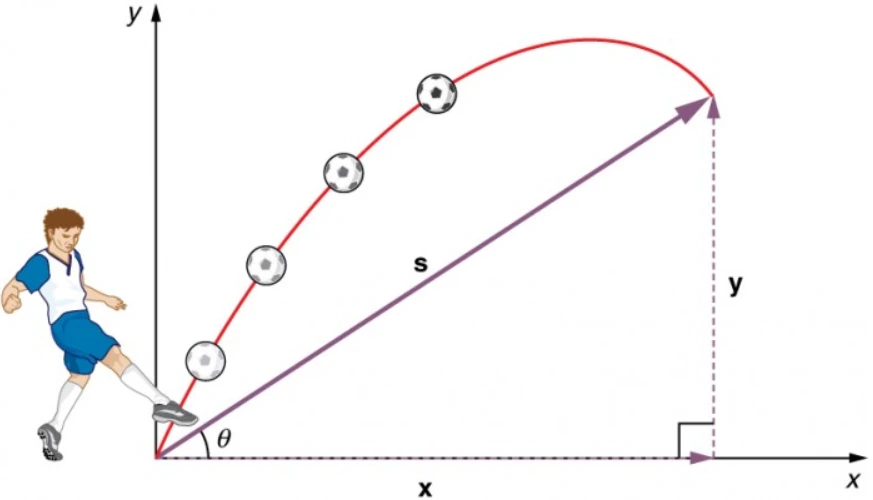Kinetic energy formula is a crucial concept of physics. It explains the work done by an object due to its movement. Kinetic energy helps us to grasp the idea of daily activities such as walking, eating, jumping, falling, etc. This comprehensive guide will guide you toward the concept of kinetic energy, the kinetic energy formula, its derivation, real-life applications, and why it is essential to understand the principle of kinetic energy.
What is kinetic energy?
Kinetic energy is the energy of an object because of its motion. Simply put, the faster the objects move or the more massive an object is, the more kinetic energy it has.
According to the definition, the kinetic energy of an object is the measure of the work it can do by its motion. In simple words, kinetic energy resides in every moving object, from a moving car to a rolling ball.
The Formula For Kinetic Energy
The derived formula to calculate kinetic energy is:
K.E. = ½ mv^2
Where
- K.E. is equal to kinetic energy (Joules, J).
- m is the mass of the object (kilograms, kg).
- v = Velocity of an object (meters per second, m/s)
This formula states that kinetic energy depends directly upon an object’s mass and the square of its Velocity.
Derivation of Kinetic Energy Formula
Here is a step-by-step breakdown to derive the k.e. formula:
- Work-energy principle: Work done to any object is equivalent to the change in its kinetic energy formula.
- Force and motion—the formula for work done (force × motion):
W = F × d × cos
(For kinetic energy, = 0, cos = 1)
- From Newton’s second law, exclude F = m × a into the equation, and now the equation becomes:
W = m × a × d
- Distance and Velocity—By using the kinematic equation:
v^2 = u^2 + 2ad and u = 0,
Now, it becomes:
d = v^2/2a
- By combining all equations and substituting d = v^2/2a into the work equation:
W = m × a × v^2 / 2a = ½ mv^2
So, the K.E. becomes:
K.E. = ½ mv^2
Factors Affecting Kinetic Energy
Many factors have a strong influence, but two are essential:
Mass of the object
Kinetic energy increases linearly with the mass. For suppose, doubling the mass makes double the kinetic energy, and their Velocity will be constant.
Velocity of the Object
Velocity is directly proportional to the square of Velocity—doubled velocity results in a fourfold increase in kinetic energy.
Real-time Applications of Kinetic Energy
Vehicles and Transportation
Cars, trains, airplanes, and bikes rely on kinetic energy for every moving object. By understanding the concept of kinetic energy, one can efficiently create braking systems and safety measures.
Sports and Athletics
Kinetic energy explains the speed of a soccer ball, the pressure of movement of a cricket bat, and the speed of football in every sport.
Space Exploration
Rockets and satellites use kinetic energy to escape from gravitational pull and to explore space.
Renewable energy
Wind turbines are one of the sources of energy conversion; they convert kinetic energy into electrical energy.
Difference between kinetic energy and potential energy
| Kinetic energy | Potential energy | |
| Definition | Energy because of motion | Energy due to the position |
| Formula | K.E = ½ mv2 | P.E = mgh |
| Dependability | Mass and velocity | Mass, gravity and height |
| Examples | A moving plane | Water stored in dam |
Unit of Kinetic Energy
Kinetic energy is a scalar quantity. It is measured in S.I. and CGS scales.
S.I. Unit
Kinetic energy is measured in Joules (J).
For example,
A car moving at 30 m/s with a mass of 2000 kg has a kinetic energy of?
K.E. = ½ mv²
½ mv^2 = ½ × 1000 × 20^2 = 200,000 Joules
CGS system
In the CGS system, the unit of kinetic energy is erg. Erg is an object’s total kinetic energy with a fixed mass of 1 gram.
How do we solve problems related to kinetic energy?
Example # 1
A biker and his bike have a combined mass of 80 kg and travel at ten m/s. Using the kinetic energy formula, find the kinetic energy.
K.E. = ½ mv²
K.E. = ½ × 80 × 10^2
K.E. = 4000 J
Example # 2 [Effect of doubling the Velocity]
If the biker from the previous example doubles his Velocity, Velocity becomes 20 m/s. Then, what will its kinetic energy be?
K.E. = ½ × 80 × 20^2
K.E. = 16000 J
When we double the Velocity, kinetic energy increases by four times.
Why is kinetic energy essential?
This concept is not just theoretical. It is also relatable to our daily lives. It helps us to understand everyday activities, including mechanics of motion, safety in engineering, and efficiently enhanced technology. The concept of kinetic energy gives us a vision of how energy transforms.
Frequently Asked Questions
Can kinetic energy be negative?
No, k.e is always positive. It depends on the Velocity and mass of the objects.
Can we triple the kinetic energy?
Yes, we can triple the kinetic energy. After tripling, kinetic energy increases by nine times.
Is kinetic energy conserved?
In any isolated system, the total energy is conserved. However, we can transform it into different forms, such as thermal and potential energy.
What is the kinetic energy definition in physics?
In physics, kinetic energy is the energy an object has due to its motion. It depends on the object’s mass and speed, calculated using the formula KE = ½ mv², where m is mass and v is velocity. The faster or heavier an object is, the more kinetic energy it possesses. This energy plays a crucial role in mechanics, collisions, and motion studies.






